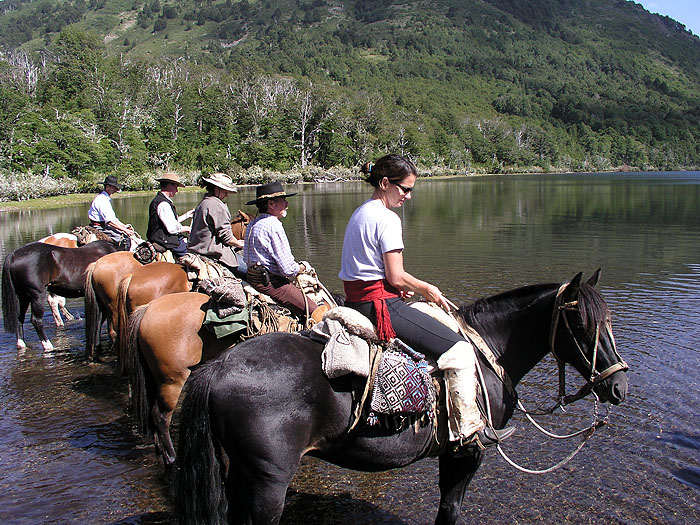Chile's chunk of Patagonia is ridden by some of the world's hardiest cowboys, men who use tough criollo horses to herd cattle across the weather-thrashed pampas, or to carry provisions into the remote, roadless camps of the mountainous Torres del Paine. Seven of us had booked to ride with a bunch of these rugged baquianos on a nine-day romp in and around the national park. We were prepared for a challenge. We got one.
Even the kit list was daunting: heavy on rain gear, warm layers, boots and hats, with just the one encouraging concession - a swimming costume, to prove that March is still summer in the southern hemisphere.Chechin, Carlos and Tata drove up a tropilla of saddled but otherwise empty horses to meet our small group at the ride's start on the shores of Laguna Azul. Across the sapphire blue of the lake, the peaks and chasms of the famed torres plunged and soared like the profit-and-loss graph of a particularly volatile internet company, tailing off into the bankruptcy of the dead flat plains.
As they trotted in, their wind-defying Basque berets and multihued tam-o'-shanters were pulled down hard on their brows. Shawls were slung bandolier-style over their leather jackets, ready to cover their faces against sun, dust or rain. Voluminous bombachas (riding trousers) billowed round their legs, and their spurs chimed like distant cathedral bells. Each had a long knife sheathed at the small of his back. We ingleses - a catch-all Spanish term for the Irish, Australian, American and English guests on the trip - felt woefully underdressed and underarsenaled by comparison.Our leaders would be Alec Quevedo, an American-Mexican-Ecuadorian surfer-cowboy, and Lian Hayes, an English rider turned wrangler. They have run Blue Green Adventures for nigh on a decade. "We can gallop nonstop for four miles," Alec warned as we set off. "The riders get tired before the horses. One of our previous riders claimed to have worn out a bra in the nine days. It can be tough going, but it's the only way to see the country."
The advantages of riding across Patagonia, disintegrating underwear apart, were fairly obvious from the start. The baquianos were condor-eyed in pointing out ostrich-like ñandu sprinting away between the calafate bushes, austral parakeets gossiping in the beeches, or crimson-and-rosé Chilean flamingos arranged around a lake like a canapé of boiled shrimps.This wasn't the usual nose-to-tail, "don't gallop, don't do anything" pony trekking. We weren't passengers being carried across the country: we were riding it into submission. We covered 20 miles or more each day. There were hours of sitting trot while we drove the packhorses and spare mounts ahead of us. But we were also free to swing off into the scrubland and take our own line cross-country. And we would start races against each other with the little "tch, tch" kissy sounds that accelerated the criollos across the plains as if flooring the pedal on a 4WD Porsche.
One morning, after an early breakfast, we set off into high country. The horses' hooves cracked through the crisp frost glittering in the bright sun and we climbed higher and higher until we reached a lofty ridge. Looking out over the whole park, and beyond to distant Argentina, it seemed as if all the geographical furniture - glaciers, mountains, rivers, lakes - had been pushed into one huge, jumbled pile in the corner for a party, leaving an infinite expanse of empty floor, the pampas, for dancing. We could trace the route we had taken during the previous week.On the ride back over the hill, the wind strengthened. With a sudden, soft thrumming of stiff pinions, a condor rode up a conveyor belt of breeze to tread air a few yards away from me, eyes meeting mine. It had the bulk of a pitbull, the wingspan of a Lancaster bomber and a beak of terrifying proportions. It hung there, estimating my life span, for a hoofbeat-measured minute, then slipstreamed off in search of easier prey.
We stayed that night at the Estancia Lazo, a working ranch on the shores of Laguna Verde. Inside the hotel was a sitting room with loose-covered sofas and a cheerful log fire. We could have been in a 1930s Cotswold inn, except for the pictures of cowboys, horses and sweeping Chilean vistas along the wall. And the bar served pisco sour, not dry sherry.Dinner was meat - naturally - and salmon pulled from the same rivers we had clattered across that day. Bottles of Chilean merlot ran in and out of our glasses. Then, pleasantly tipsy, and in imitation of the landscape outside, we pushed the room's furniture into a corner, rolled up the carpet and plugged in a cassette-player. The baquianos had unbuckled their spurs and doffed their berets, ready to dance. The music that started up was thin and tinny, but the beat was taken up by 20 boot heels as, cowboys and ingleses together, we broke into swirling salsa. Whooping and galloping, we danced as we'd ridden our horses across the pampas: recklessly, ecstatically and bow-legged.

